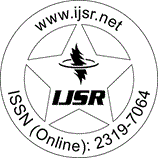Downloads: 112
Kuwait | Medicine Science | Volume 4 Issue 11, November 2015 | Pages: 1044 - 1052
Evaluation of Small Bowel Bacterial Overgrowth Syndrome (SBBOS) in Egyptian Patients with Unexplained Gastrointestinal Symptoms: Histopathologic Features and Clinical Correlates in an Under Recognized Entity
Abstract: Small bowel bacterial overgrowth syndrome (SBBOS) is a disorder of excessive bacterial growth in the small intestine. Unlike the colon (or large bowel), which is rich with bacteria, the small bowel usually has fewer than 104 organisms per milliliter. Patients with bacterial overgrowth typically develop symptoms including nausea, bloating, vomiting, diarrhea, malnutrition, weight loss and mal-absorption which is caused by a number of mechanisms. Morphologic changes associated with this condition have not, to our knowledge, been studied in detail. Objective To better characterize the histopathologic changes associated with SBBOS by comparing the clinico-pathologic features of patients with SBBOS ( duodenal aspirate cultures with - 105colony-forming units [CFUs]/mL) to controls with cultures found to be negative (<105CFUs/mL). Design We included 28 consecutive patients with SBBOS and 21 controls in the series. Each duodenal biopsy was assessed for the following features villous to crypt ratio, intraepithelial lymphocytosis, crypt apoptoses, basal plasmacytosis, cryptitis/villitis, pepticduodenitis, erosions/ulcers, eosinophilia, andabsenceofgobletandPanethcells, and correlated with clinical features and culture results. Results Decreased villous to crypt ratio (<31) was more frequent in SBBOS than controls (25 %versus5 %, P=< 0.01). There were no significant differences in any of the other histologic features. Clinically, patients in the SBBOS group were older than the age of controls (mean, 58.4 11.7years versus 50 10.4 years, P=< 0.05), and they were more likely to have one of the known predisposing factors for bacterial overgrowth (68 % versus 38 %, P = < 0.05). Other Clinical features, including presenting symptoms, were similar. ConclusionsVillous blunting is the only feature more common of SBBOS than controls. More than half of biopsies from SBBOS patients are histologically unremarkable. Therefore, SBBOS needs to be considered as a potential etiology for gastrointestinal symptoms even when duodenal biopsies are found to be normal.
Keywords: SIBO, jeujeunal culture, histopathology, biopsy, hydrogen breath test
How to Cite?: Yasser S. Sheta, Abdallah Nawara, Elsayed A. Elgohary, Abeer M. Hafez, Samar S. Morsi, "Evaluation of Small Bowel Bacterial Overgrowth Syndrome (SBBOS) in Egyptian Patients with Unexplained Gastrointestinal Symptoms: Histopathologic Features and Clinical Correlates in an Under Recognized Entity", Volume 4 Issue 11, November 2015, International Journal of Science and Research (IJSR), Pages: 1044-1052, https://www.ijsr.net/getabstract.php?paperid=NOV151343, DOI: https://dx.doi.org/10.21275/NOV151343
